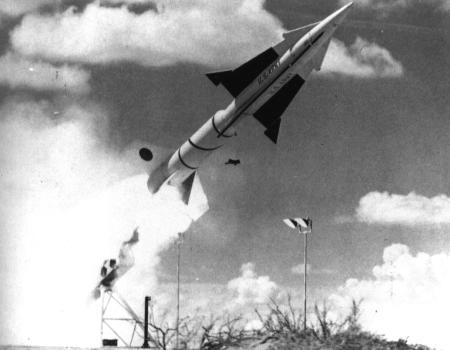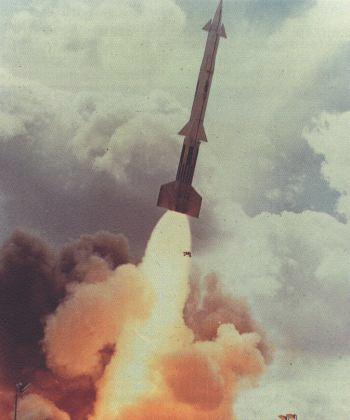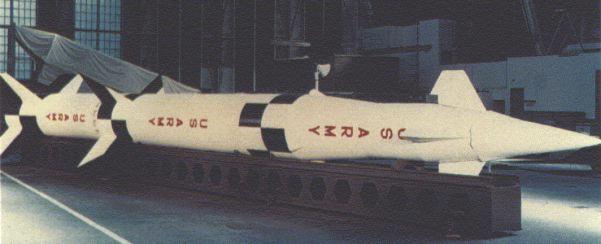Western Electric/McDonnell Douglas LIM-49 Nike Zeus/Spartan
In 1955 the U.S. Army began to study the possibility to develop a derivative of the MIM-14 Nike Hercules as an interceptor against hypersonic aircraft and ballistic missiles. This project was originally called Nike II, but renamed Nike Zeus on 15 November 1956. It is highly probable that Nike II was briefly known as either SAM-A-24 or SAM-A-26, but I can't confirm any of these designators. Because of a December 1956 DOD directive, which restricted the range of Army guided missiles to 320 km (200 miles), the Nike Zeus could not be designed as an exo-atmospheric intercept missile. Therefore, Western Electric started to develop an enhanced version of Nike Hercules, designed to intercept ballistic warheads within the earth's atmosphere. This project was named Nike Zeus A.
The Nike Zeus A missile was a relatively straight-forward development of the MIM-14 Nike Hercules. It was to use essentially the same command-guidance ground equipment as the Nike Hercules, and would be armed with a 20 kT nuclear warhead. The first successful flight of a full two-stage missile occurred in March 1960. However, in 1957 the Army missile range limitation had been rescinded (after the Sputnik launch), and the main development effort had already turned towards an exo-atmospheric anti-ballistic missile interceptor, called Nike Zeus B.
Several sources, including [1] and [2] listed below, say that the Nike Zeus A was designated as XLIM-49A in 1963, even if development had long been halted then. However, the official sources [3] and [4] clearly indicate that XLIM-49A was actually allocated to the later Nike Zeus B (which see below).
 |
| Photo: U.S. Army |
| Nike Zeus A |
The Nike Zeus B was a completely new missile, which shared only the guidance method and first stage booster with the Nike Zeus A. Because it was designed to intercept its targets in space, it did not need large manoeuvering fins. Instead the missile featured a special third stage with small control jets to manoeuver in space. The first three-stage flight of a Nike Zeus B occurred in September 1961. In July 1962, a Nike Zeus B succeeded in intercepting an Atlas ICBM nose cone. By the end of 1963, more than a dozen reentry vehicles had been successfully intercepted. Source [1] says that the designation XLIM-49B was allocated to the Nike Zeus B in 1963. However, as said above, official records show that Nike Zeus B was actually the XLIM-49A.
In May 1963, a modified Nike Zeus B missile intercepted an orbiting satellite. From June 1963 until May 1966, a Nike Zeus B with a live nuclear warhead was always on alert at the Kwajalein launch complex for possible interception of Soviet satellites.
 |
| Photo: U.S. Army |
| Nike Zeus B (XLIM-49A) |
Because the Nike Zeus B system was planned to use mechanical radars, it was deemed too slow to be effective. It could also handle only few different targets at a time, and was inefficient at filtering out decoys. Therefore, the whole system was redesigned to use electronically scanned phased-array radars. Additionally, it was decided to complement the Nike Zeus B with an endo-atmospheric interceptor to defend against submarine-launched ballistic missiles (which followed a far shallower trajectory than ICBMs). This new system was named Nike-X.
The exo-atmospheric missile of the Nike-X system was to be a longer-range development of Nike Zeus B, called Extended Range Nike Zeus or Nike Zeus EX. In 1965, Western Electric received the prime contract for this missile. However, on 18 September 1967, the Nike-X was cancelled and replaced by a system called Sentinel, which was to be a much thinner (and therefore cheaper!) ABM defense shield. At the same time, Nike Zeus EX was renamed Spartan, and the prime contract was now shared between Western Electric and McDonnell Douglas. The Spartan missile received the designation LIM-49A. The short-range, endo-atmospheric missile component of Sentinel was the Martin Marietta Sprint.
The LIM-49A Spartan was stored in and launched from underground silos, and the first Spartan launch occured in March 1968. In August 1970, an LGM-30 Minuteman RV was intercepted for the first time. In 1969, however, the Sentinel system had been cancelled, and replaced by Safeguard, an ABM system planned to defend only SAC's ICBM bases, and not the cities of the United States. The SALT I treaty of 1972, and a 1974 addendum, limited even this to one site with 100 ABMs. On 1 October 1975, the U.S.'s one and only Safeguard ABM site became operational with 30 Spartan and 70 Sprint missiles. However, because the very limited defense offered by a single ABM site did not warrant the costs, the site was deactivated by Congress the next day.
 |
| Photo: U.S. Army Strategic Defense Command |
| LIM-49A |
Note: The designations of the various Nike Zeus, Nike-X and Spartan missiles are a bit confusing. Many sources say that the Nike Zeus A received the designation XLIM-49A in 1963, although development had stopped in 1960, and Nike Zeus B became XLIM-49B, although it had almost nothing in common with the Zeus A. However, official DOD records describe the XLIM-49A as a three-stage intercept missile. Although the name is given only as plain Nike Zeus, without an A or B suffix, "three-stage" clearly points to the Nike Zeus B. The designation LIM-49A for the Spartan makes sense, because Spartan was indeed a modified/improved Zeus B, but had nothing in common with the Nike Zeus A. Zeus A itself had received no designation, which is quite logical, because it didn't exist anymore in 1963.
Further adding to the ABM designation confusion is that all my sources say the short-range Sprint did not receive any LIM-n designation, and the existence of the very little-known XLIM-99A and XLIM-100A designations, reserved by the U.S. Army in 1972. Whether one or both of the LIM-99/100 designators is related to the Spartan and/or Sprint missiles, I don't know for sure.
Specifications
Note: Data given by several sources show slight variations. Figures given below may therefore be inaccurate!
Data for Nike Zeus A/B and LIM-49A:
| Nike Zeus A | Nike Zeus B (XLIM-49A) | LIM-49A | |
|---|---|---|---|
| Length | 13.5 m (44 ft 3 in) | 14.7 m (48 ft 4 in) | 16.8 m (55 ft 2 in) |
| Span | 2.98 m (117.6 in) | 2.44 m (96 in) | 2.98 m (117.6 in) |
| Diameter | 0.91 m (36 in) | 1.09 m (43.1 in) | |
| Weight | 4980 kg (11000 lb) | 10300 kg (22800 lb) | 13100 kg (29000 lb) |
| Speed | > Mach 4 | ||
| Ceiling | ? | 280 km (174 miles) | 560 km (350 miles) |
| Range | 320 km (200 miles) | 400 km (250 miles) | 740 km (460 miles) |
| Propulsion |
Two solid-fuel rocket stages 1st stage: Thiokol TX-135; 1800 kN (400000 lb) 2nd stage: ? |
Three solid-fuel rocket stages 1st stage: Thiokol TX-135; 2000 kN (450000 lb) 2nd stage: Thiokol TX-238 3rd stage: Thiokol TX-239 |
Three solid-fuel rocket stages 1st stage: Thiokol TX-500; 2200 kN (500000 lb) 2nd stage: Thiokol TX-454 3rd stage: Thiokol TX-239 |
| Warhead | W-31 nuclear (20 kT) | W-50 thermonuclear (400 kT) | W-71 thermonuclear (5 MT) |
Main Sources
[1] James N. Gibson: "Nuclear Weapons of the United States", Schiffer Publishing Ltd, 1996
[2] Bill Gunston: "The Illustrated Encyclopedia of Rockets and Missiles", Salamander Books Ltd, 1979
[3] DOD: "Model Designation of Military Aircraft, Rockets and Missiles", 7/1964, 1/1965, 7/1965
[4] Department of Defense Missile Nomenclature Records
Back to Current Designations Of U.S. Unmanned Military Aerospace Vehicles
Back to Directory of U.S. Military Rockets and Missiles
Last Updated: 24 December 2002